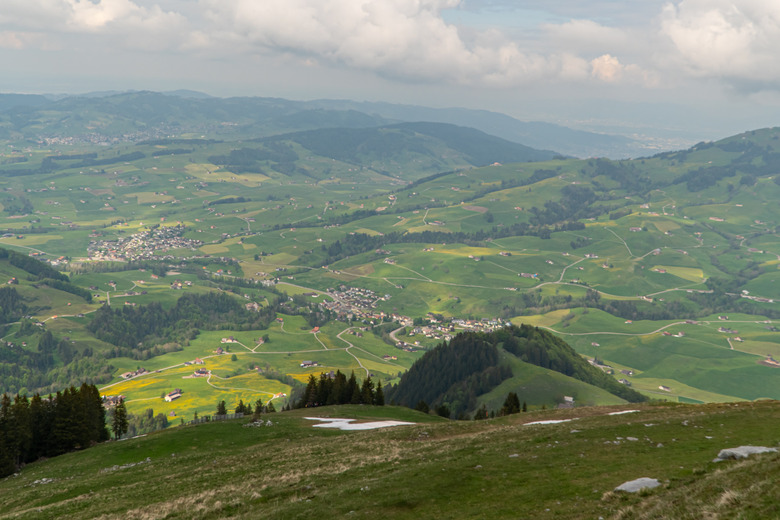How To Do A Grassland Ecosystem Project In A Shoe Box
In the early days of the United States, settlers traveled in covered wagons across hundreds of miles of vast, rolling grasslands sometimes known as prairies. Grassland ecosystems are comprised of grasses and herbs and flowers, as well as hundreds of species of animals. Few trees live in these places, however. You can create your very own miniature grassland ecosystem in a shoe box.
Step 1
Measure a sheet or sheets of blue construction paper to line the internal sides, back and top of your shoe box when it is laying horizontally, with the opening facing you. You may need to tape together more than one sheet of paper. Once you have measured the sheets, set them aside. Do not attach them to the inside of the box yet.
Step 2
Draw your sky. Use chalk or white crayons to draw clouds on the blue construction paper, and you can even shade the paper with different colors of blue. Use a black or brown marker to draw some birds that flying in the distance. Color a bright sun with yellow and orange markers. You can also cut out shapes of clouds and a sun from construction paper and glue or paste these to your sky.
Step 3
Tape or glue your sky inside the box.
Step 4
Glue or paste green construction paper to the bottom of your ecosystem. You may need to cut it to fit. Measure another piece of green paper to line the back of the box, but cover only the lower fourth of the back of the box. Cut this paper with jagged edges along the top so that it looks like grass. Paste this sheet in the back of the box, with the grass at the top.
Step 5
Research grasslands and brainstorm a list of animals and plants you'd like to include in your box. Grasslands are home to coyotes, eagles, wolves and bison, among many other animals. Common plants found in grasslands are sunflowers, asters, goldenrod and clover. Find pictures of these plants and animals online or in books.
Step 6
Draw the animals you'd like in your ecosystem on construction paper, using the pictures you found as a guide. Use your markers and crayons to give the animals as much detail as you can. At the bottom of each animal, draw a small tab that you can fold under the animal so it can stand up. Birds don't need tabs.
Step 7
Cut out your animals. Ask an adult to help you with the scissors.
Step 8
Fold the tabs on your animals and then put a small drop of glue on the bottom of each tab. Glue the animals in the place where you'd like them to be in your ecosystem. You could be creative and have a wolf chasing a bison.
Step 9
Glue a piece of string or fishing line to the top of any birds that you drew and tape or glue the birds from the inside top of the box. Be sure to measure the string ahead of time so your birds don't hang down too low.
Step 10
Add a blue construction-paper watering hole. Bison might be drinking there, for example. You also can draw and cut out one or two trees, but remember that not many trees live in grasslands because the soil is thin and dry.
Step 11
Sprinkle bits of dirt and real pieces of grass and clover on the ground inside your box to create realistic details.
Things Needed
- Construction paper
- Chalk
- Crayons or markers
- Scissors
- Glue, paste or tape
- Pictures of animals
- String or fishing line
- Grass and clover
- Dirt
Cite This Article
MLA
Osborne, Kristen. "How To Do A Grassland Ecosystem Project In A Shoe Box" sciencing.com, https://www.sciencing.com/do-ecosystem-project-shoe-box-8555982/. 22 November 2019.
APA
Osborne, Kristen. (2019, November 22). How To Do A Grassland Ecosystem Project In A Shoe Box. sciencing.com. Retrieved from https://www.sciencing.com/do-ecosystem-project-shoe-box-8555982/
Chicago
Osborne, Kristen. How To Do A Grassland Ecosystem Project In A Shoe Box last modified August 30, 2022. https://www.sciencing.com/do-ecosystem-project-shoe-box-8555982/
